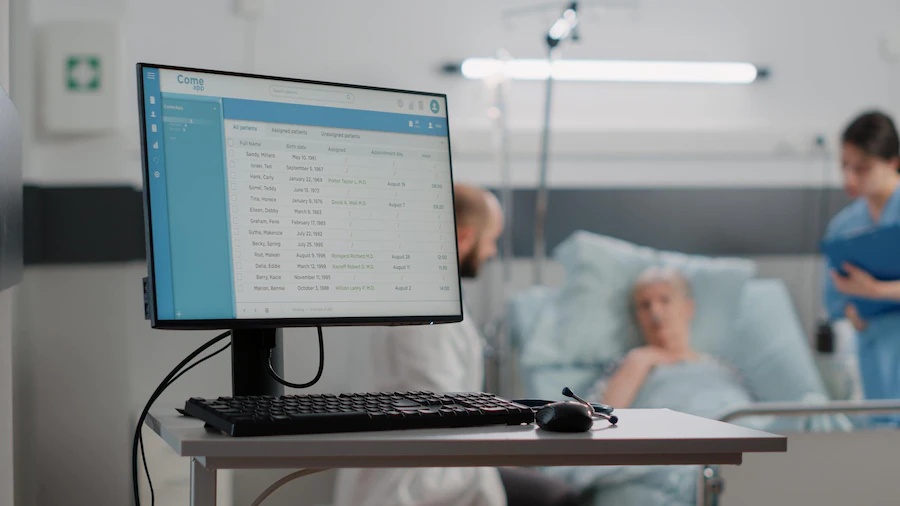
Healthcare Workflows: From Chaos to Order
Healthcare providers face numerous challenges when managing patient information and workflows. From scheduling appointments to tracking medical histories, the sheer volume of data can quickly become overwhelming, leading to delays, errors, and decreased patient satisfaction. However, patient management software transform healthcare workflows by streamlining processes, reducing administrative burdens, and improving patient outcomes.
In this blog, we’ll explore the benefits of patient management software and how they can help healthcare providers go from chaos to order in their day-to-day operations.
Choosing and Implementing Patient Management Software
Patient management software applications designed to help healthcare providers manage patient information and workflows more efficiently. These tools can range from electronic health records (EHRs) to appointment scheduling systems and patient portals.
These tools can help streamline workflows, reduce administrative burdens, and improve patient outcomes by digitizing patient data and automating manual processes.
The benefits of patient management software are numerous. For one, they can help healthcare providers access patient information more quickly and accurately, improving diagnosis and treatment decisions. They can also reduce the risk of errors and duplicate records, improving patient safety.
Additionally, patient management software can help providers coordinate care across different departments and settings, leading to better patient outcomes and increased satisfaction.
The Challenges of Traditional Patient Management

Traditional patient management involves manually managing paper records or using outdated spreadsheets and legacy software. This can lead to several challenges that can negatively impact healthcare providers, patients, and the overall quality of care.
One common issue is the need for more access to patient information quickly and accurately. With paper records, providers must manually search through files to find the necessary information, which can be time-consuming and prone to errors. Similarly, outdated software systems may need more robust search capabilities, making it challenging to find relevant patient information quickly.
Another area for improvement is the need for integration between different systems and departments. For example, scheduling appointments, tracking patient histories, and coordinating care between providers and facilities can be difficult when each system operates independently. This can lead to delayed care, duplicate records, and reduced patient satisfaction.
In addition, manual processes and outdated systems can burden healthcare providers, who may spend significant time on administrative tasks such as data entry and record-keeping. This can lead to burnout and decreased job satisfaction, ultimately impacting the quality of care provided.
Delays in care can lead to worsened health outcomes, increased healthcare costs, and decreased patient satisfaction. Errors, such as incorrect dosages or missed appointments, can lead to adverse events and legal liability. The lack of integration and coordination can result in fragmented care and reduced provider communication, leading to suboptimal treatment plans and outcomes.
A streamlined and automated approach to patient management is necessary to address these challenges. This is where patient management software come into play. These tools can digitize patient information, automate manual processes, and improve communication and coordination between providers and departments. They can help reduce administrative burdens, improve the quality of care, and increase satisfaction.
Benefits of Patient Management Software

Patient management software have numerous benefits that can improve the efficiency and effectiveness of healthcare delivery. Some of the key features and benefits of these tools include the following:
1. Electronic Health Records (EHRs):
EHRs are digital versions of patient health records that contain all relevant medical information. This includes patient demographics, medical history, test results, diagnoses, and treatment plans.
By digitizing patient information, EHRs allow healthcare providers to access patient data quickly and accurately, reducing the risk of errors and delays in care. EHRs can also improve communication between different providers and departments, leading to better coordination of care and improved patient outcomes.
2. Patient Portals:
Patient portals are web-based tools that allow patients to access their medical records, schedule appointments, and communicate with their healthcare providers. Patient portals can improve patient engagement and satisfaction by providing patients with easy access to their medical information.
Patient portals can also reduce administrative burdens for healthcare providers by allowing patients to schedule appointments and communicate with providers online.
3. Appointment Scheduling Systems:
Appointment scheduling systems can help healthcare providers manage their schedules more efficiently, reducing wait times and improving patient satisfaction.
By automating appointment scheduling and reminders, providers can reduce the risk of missed appointments and improve patient outcomes.
Improving Patient Engagement and Satisfaction with Patient Portals

The benefits of patient management software are numerous. By automating manual processes and digitizing patient information, these tools can save time and reduce administrative burdens for healthcare providers. This allows providers to focus on patient care, leading to better patient outcomes and increased satisfaction.
The adoption of EHRs has been shown to improve the quality of care in several studies. A study by the Agency for Healthcare Research and Quality found that EHRs improved the quality of care for patients with chronic diseases by strengthening provider communication and reducing the risk of errors. Another study published in the Journal of General Internal Medicine found that EHRs improved the accuracy of medication lists and reduced the risk of adverse drug events.
Patient portals have also been shown to have numerous benefits. A study published in the Journal of Medical Internet Research found that patient portals increased patient engagement and satisfaction with care. Another study published in the Journal of the American Medical Informatics Association found that patient portals improved communication between patients and providers and reduced the risk of missed appointments.
Appointment scheduling systems can also improve the efficiency of healthcare delivery. A study published in the Journal of Healthcare Management found that appointment scheduling systems reduced patient wait times and improved patient satisfaction. Another study published in the Journal of Medical Systems found that appointment scheduling systems reduced the number of missed appointments and improved patient outcomes.
Choosing the Right Patient Management Software
Here are some tips for evaluating different options and making an informed decision:
Identify Your Needs
The first step in selecting a patient management software is to identify your healthcare organization’s specific needs and workflows. Consider the size of your organization, the number of patients you serve, and the particular challenges you face in managing patient information.
Evaluate Different Options:
Once you have identified your needs, evaluate different patient management software to determine the best fit for your organization. Consider cost, ease of use, and compatibility with your existing systems. Look for tools that offer features that are specifically designed to meet your needs, such as appointment scheduling or patient portals.
Consider Implementation and Training:
When selecting a patient management software, it is important to consider the implementation and training process. Look for agencies offering comprehensive training and support to ensure your staff can use the tool effectively.
Ensure Data Security and Privacy:
Patient information is compassionate, so selecting a patient management tool that prioritizes data security and privacy is essential. Look for agencies that comply with the United States’ relevant healthcare data privacy regulations, such as HIPAA.
Plan for Future Growth:
Finally, consider how your healthcare organization may grow and change. Look for patient management tools that can scale with your organization and accommodate future growth.
KiviCare - The Complete Solution for Medical Consulting Services
Running a medical consulting service can be a challenge, but KiviCare makes it easy! This clinic and patient management system in WordPress theme has everything you need to manage your clinic and provide top-notch care to your patients. With its exclusive home pages for specialties like Fertility and ENT, KiviCare – Complete clinic management solution allows you to showcase your expertise and attract the right clients.
And with WooCommerce compatibility, you can even turn your site into a profitable eCommerce venture. But what really sets KiviCare apart is its ease of use. The Elementor Page Builder and Slider Revolution Responsive WordPress plugins make site development a breeze, while the KiviCare Razorpay WordPress Plugin ensures seamless integration with WooCommerce and patient management systems.
But the real game-changer is the Telemed and WooCommerce Payment Gateway add-ons and Clinic and Patient Management System EHR. With these tools, you can easily manage patient data and ensure that your client’s information is secure and easily accessible from anywhere.
So if you’re ready to take your medical consulting service to the next level, don’t hesitate – to choose KiviCare today!